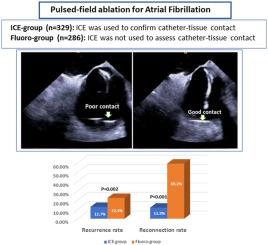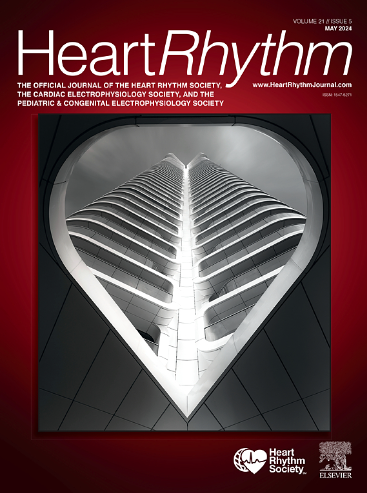Ensuring catheter-tissue contact with intracardiac echocardiography during pulsed-field ablation improves procedure outcome in patients with atrial fibrillation
IF 5.7
2区 医学
Q1 CARDIAC & CARDIOVASCULAR SYSTEMS
引用次数: 0
Abstract
Background
Catheter-tissue contact is critical in creating durable lesions during pulsed-field ablation (PFA) of atrial fibrillation (AF).
Objective
This study aimed to compare the reconnection rate of previously ablated targets using PFA with vs without intracardiac echocardiography (ICE) guidance for confirmation of tissue contact.
Methods
This multicenter prospective study included consecutive patients with paroxysmal and persistent AF undergoing their first procedure using the PFA system. Patients were classified as the ICE group if ICE was used for the assessment of catheter-tissue contact (n = 310) or the fluoro group if fluoroscopy-guided ablation was used (n = 286). All patients received isolation of pulmonary veins; left atrial posterior wall isolation was performed in most patients at the index procedure. Further ablations were performed only in the presence of spontaneous triggers or documentation that those triggers were responsible for arrhythmia either spontaneously or after isoproterenol challenge.
Results
Baseline characteristics were comparable between the groups. At the end of the follow-up, arrhythmia recurrence was noted in 39 (12.6%) and 64 patients (22.3%) in the ICE and fluoro groups, respectively (P = .002). All 39 patients in the ICE group and 54 patients (84%) in the fluoro group received repeat ablation. At the redo procedure, reconnection of previously ablated structures was detected in 4 of 39 (10.3%) and 32 of 54 patients (59.2%) in the ICE and fluoro groups, respectively (P < .001). “Fluoroscopy-guided” ablation was found to be an independent predictor of reconnection (odds ratio 8.548; 95% confidence interval 3.224–22.667; P < .001) and recurrence (odds ratio 1.221; 95% confidence interval 1.001–1.971; P = .021).
Conclusion
ICE-guided PFA with confirmed catheter-tissue contact was associated with a better success rate and a significantly lower reconnection rate in patients with AF.

在脉冲场消融过程中,确保导管组织与心脏内超声心动图的接触可改善心房颤动患者的手术结果。
背景:心房颤动(AF)脉冲场消融(PFA)过程中导管-组织接触对于产生持久病变至关重要。目的:我们旨在比较使用PFA与不使用心内超声心动图(ICE)指导确认组织接触的先前消融目标的重连率。方法:这项多中心前瞻性研究包括连续阵发性和持续性房颤患者,他们首次使用PFA系统进行手术。如果将ICE用于评估导管-组织接触(n=310),则将患者分为ICE组(n=310)或fluoro组(n=286)。所有患者均接受pv分离(PVI);左房后壁(LAPW)在大多数情况下在索引程序。进一步消融仅在存在自发触发或有文件证明这些触发是自发或异丙肾上腺素刺激后导致心律失常的情况下进行。结果:两组间基线特征具有可比性。随访结束时,ICE组和氟组分别有39例(12.6%)和64例(22.3%)患者出现心律失常复发(p=0.002)。ice组的39例患者和氟组的54例(84%)患者接受了重复消融。在重做手术中,ICE组和氟组分别在4/39(10.3%)和32/54(59.2%)患者中检测到先前消融的结构重新连接(PFA)。结论:ICE引导的PFA确认导管-组织接触与房颤患者的成功率更高,重新连接率显著降低。
本文章由计算机程序翻译,如有差异,请以英文原文为准。
求助全文
约1分钟内获得全文
求助全文
来源期刊

Heart rhythm
医学-心血管系统
CiteScore
10.50
自引率
5.50%
发文量
1465
审稿时长
24 days
期刊介绍:
HeartRhythm, the official Journal of the Heart Rhythm Society and the Cardiac Electrophysiology Society, is a unique journal for fundamental discovery and clinical applicability.
HeartRhythm integrates the entire cardiac electrophysiology (EP) community from basic and clinical academic researchers, private practitioners, engineers, allied professionals, industry, and trainees, all of whom are vital and interdependent members of our EP community.
The Heart Rhythm Society is the international leader in science, education, and advocacy for cardiac arrhythmia professionals and patients, and the primary information resource on heart rhythm disorders. Its mission is to improve the care of patients by promoting research, education, and optimal health care policies and standards.
 求助内容:
求助内容: 应助结果提醒方式:
应助结果提醒方式:


